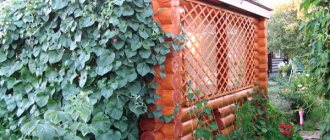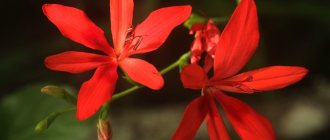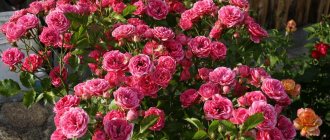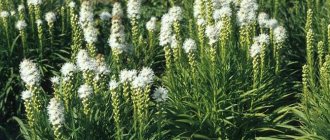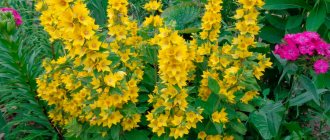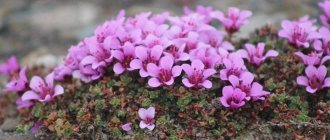Charming delphinium growing quickly
Growth rate
This is the rate at which a species reaches its maximum height or increases in size over a certain period of time .
Most perennials grow quickly in the initial period of development, and with the beginning of budding and flowering, growth in height slows down. This is understandable: all efforts go towards flowering and further development of the ovary. During the flowering period, high elecampane reduces the growth rate. Photo by the author
The growth rate depends on the stage of plant development .
- Infancy, childhood - juvenile stage .
- Adolescence - virginal .
- Youth, maturity - generative . It is during this period that plants are able to give birth to a new strong generation: cuttings can be taken from them and seeds collected. And division will “restore youth,” and with it, rapid growth of the plant itself.
- Old age - senile stage . Cuttings or divisions taken during this period (it can be determined by the depressed state of the plant and weak flowering), even in excellent conditions, will most likely remain “weak old people” from which you will not expect either good growth or abundant flowering.
Ads by
Growth direction
There is a distinction between height and width. There are orthotropic (vertical), creeping plagiotropic (horizontal) and climbing plagiotropic (vines, the growth of which often depends on the height of the support and the characteristics of cultivation) plants.
There are much more of the first ones, reaching towards the sun. Loosestrife 'Golden Bells' with plagiotropic growth. Photo by the author
This is important: the reference literature indicates the height and width of plants in optimal conditions for each species, as close as possible to natural conditions.
What determines the growth rate?
The growth rate is determined by: 1) the totality of the biological characteristics of the species, 2) soil and climatic conditions, 3) the level of agricultural technology.
The first factor is conservative and practically cannot be adjusted. But highly cultivated soils and good care (timely watering and fertilizing, proper pruning) can significantly accelerate growth.
Tall dahlias
Creating very good conditions can even change the appearance of the plant as a whole: for example, the squat alpine edelweiss (Leontopodium alpinum), usually growing as a succulent, can lose its silver color and become completely green, elongated, lodging.
You can enhance and accelerate growth, from seed to flowering, using special means - growth stimulants.
You can find a large assortment of various drugs for stimulating growth in our catalog, which combines offers from various gardening online stores. View a selection of growth stimulants.
AVA (AVA) Spring, 200 g 229 rub.
seedspost.ru
Natural vitalizer HB-101, 100 ml RUB 1,838
seedspost.ru
AVA (AVA) UNIVERSAL 1 year, 250 g 321 rub.
seedspost.ru
Epin extra 25 rub.
Russian Vegetable Garden
And you can slow down growth by pinching (trimming the top of a shoot) and retardants - drugs that slow down plant growth.
For example, “Athlete,” which helps many summer residents prevent flower and vegetable seedlings from overgrowing. You can learn more about such drugs in the article Harvest on a schedule. How to use retardants and inhibitors. According to height, flowering plants are:
- high (over 100 cm),
- medium (50-100 cm),
- low (up to 50 cm in height).
Species that are naturally given the ability to grow quickly can be very useful for summer residents from a practical point of view: they will help in a short time to green up an area, fill an empty flowerbed, create a “green screen” or decorate an unsightly fence. Let’s roughly divide them into 3 groups: tall perennials, herbaceous vines, and bulbous ones.
Tall perennials
Here the undisputed champions are herbaceous species. There are quite a lot of them, especially if you consider the tall varieties:
- New England aster (Aster novae-angliae),
- cultural dahlia (Dahlia x cultorum),
- garden canna (Canna x hybrida),
- Sakhalin reynutria (Reynoutria sachalinensis),
- elecampane (Inula helenium),
- dissected rudbeckia (Rudbeckia laciniata) and others.
Garden canna, variety 'Pretoria', during active growth.
Photo by the author In this group there are perennials (including rosette species) that increase in height not due to the growth of vegetative (non-flowering) shoots, but thanks to spectacular peduncles:
- delphinium (Delphinium),
- spiny artichoke (Cynara scolymus),
- buzulnik (Ligularia),
- Basil (Thalictrum),
- mullein (Verbascum),
- foxglove (Digitalis purpurea),
Tall flower stalks of foxglove purpurea
- aconite (Aconitum),
- goldenrod (Solidago),
- black cohosh (Cimicifuga),
- loosestrife (Lythrum salicaria),
- heart-shaped Macleaya (Macleaya cordata),
- soft acanthus (Acanthus mollis) and others.
Moreover, rhizomatous species (maleaea, goldenrod) quickly grow in width, forming dense thickets.
When planting such plants, it is necessary to immediately limit the distribution area with various materials, digging them to the depth of the roots. Thickets of maquea cordate and goldenrod. Photo by the author
Let’s not forget to include here the charming cereal record holders:
- reed arundo (Arundo donax),
- miscanthus (Miscanthus) and others.
The variegated form of arundo grows very quickly in sunny places in spring.
Photo by the author You will probably find all the plants described in this section in our catalog, which contains offers from many large garden online stores. Choose fast-growing perennials.
Ground cover rose SCARLET MEIDILAND 890 RUR
Good season
Rose Caramella 890 RUR
Good season
Rose Morden Blush (cream) 890 RUR
Good season
Rose Henry Kelsey (red) 890 RUR
Good season
List of unpretentious annual flowers that can be sown as seedlings
Many beautiful annual flowers are completely unassuming. Growing them in your garden and caring for them is very simple!
Marigold
Marigolds (or Marigolds, Chernobrivtsy, Tagetes) are one of the most cheerful flower crops in the garden. In addition to open ground, marigolds can be grown on a western or eastern balcony. The bright yellow and orange color evokes pleasant associations with the sun. Flowering usually begins in early summer and lasts until frost. Annual marigolds are very easy to grow; they are unpretentious and undemanding. If you choose the right place to grow tagetes in open ground, you can completely forget about the plant, except for watering. The place should be sunny, with loose, water- and breathable, neutral, moderately fertile soil. In addition to their unpretentiousness, I would like to note the phytoncidal and insecticidal properties of marigolds, thanks to which they repel pests and prevent the proliferation of pathogens.
It is better to sow marigold seedlings in early April, because the seedlings grow quite quickly. Seeds are sown in individual cups or plastic cassettes to a depth of 1 centimeter and covered with soil. Planting in a common box is also not prohibited; you need to make rows 1 cm deep at a distance of 2-3 cm, the seeds are distributed in a furrow with an interval of 2 cm, and covered with earth on top.
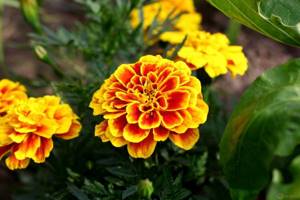
Calendula
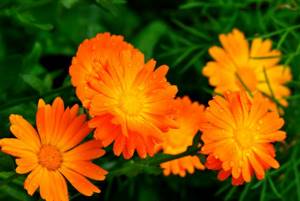
Calendula (or Marigold) is very easy to grow in the garden. Bright and perky flowers can delight from June until frost. It also has useful insecticidal and phytoncidal properties that protect it and neighboring plants from pests and fungi. The picky annual crop prefers sunny areas with fertile soil (although in general it is unpretentious to soil!).
You can plant calendula seedlings in the second half of March, in the first half of April. It is recommended to sow immediately into individual cups or cassettes. Calendula seeds are placed in a hole 2 cm deep and covered with earth on top. By the way, it is recommended to prepare the planting material by soaking them in a solution of a growth stimulator before sowing.
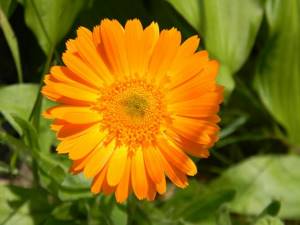
Cosmea
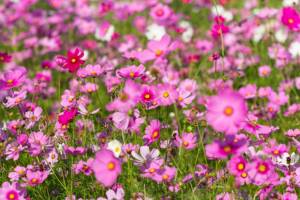
Cosmea (or Cosmos) is characterized by its delicate, sweet, weightless beauty, and at the same time it is one of the most unpretentious annuals. It blooms all summer until late autumn. Even an inexperienced novice gardener can cope with the task of growing cosmos in open ground. Letnik reproduces well by self-sowing. It is not picky in growing conditions, but for maximum flowering beauty, planting in a sunny, open area with light, nutritious, loose soil is recommended.
Planting cosmos seedlings is very simple: fill the cups with soil mixture, place 1-2 seeds on the surface of one container and lightly press them into the substrate. You should not cover it with soil.
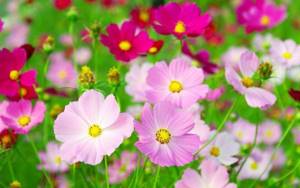
Eschszolzia
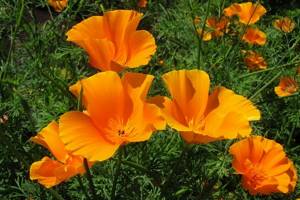
Eschscholzia (or California poppy) is a very hardy and unpretentious plant, and this is not surprising, because the flower’s homeland is the semi-deserts of North America. Therefore, you can safely grow drought-resistant and undemanding watering Eschscholzia without special care. Bright yellow and orange flowers bloom from early summer to mid-autumn. If you do not remove faded inflorescences, then propagation by self-sowing is possible.
It is optimal to sow Eschscholzia for seedlings in early March. Seeds are sown immediately in separate cups, peat tablets or plastic cassettes; there should be one or two seeds in one container; they are covered with a 1 mm layer of sand or soil on top. After planting, it is necessary to place the containers in the refrigerator for 2-3 days, and then move them to warm conditions.
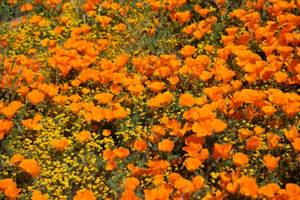
Zinnia
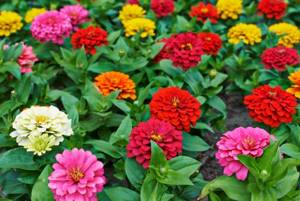
Zinnia can be a real treasure for any gardener. With minimal care, it can delight with its spectacular beauty and long flowering (from early summer until the first frost). It is resistant to pests, diseases, and drought conditions. However, she needs a sunny, warm, wind-protected place with a nutritious, neutral substrate.
It is optimal to plant zinnia seedlings at home in early April. To grow seedlings, you should initially choose individual cups, cassettes, and peat tablets. Seeds are sown in holes 3-5 mm deep and covered with soil on top.
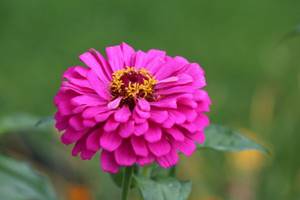
Purslane
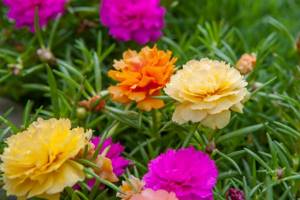
Decorative purslane has beautiful flowers and fleshy oblong leaves. The flower is completely unpretentious in care, quickly grows over the surface of the soil, forming something like a carpet (that’s why the flower is often called a “rug”). Blooms throughout the summer. Purslane is resistant to hot and dry conditions, pests and diseases. Of the care features, it is only worth noting regular watering in hot weather, but it should be moderate to avoid excess moisture. It is recommended to plant in open ground in the most illuminated, open place; the picky crop feels best on sandy, dry, poor soils.
Purslane is sown for seedlings at the end of March, at the beginning of April. The container should be wide and shallow, and the soil mixture should contain a large amount of sand. It is necessary to sow superficially; it is convenient to mix them with sand and sow.
Alyssum
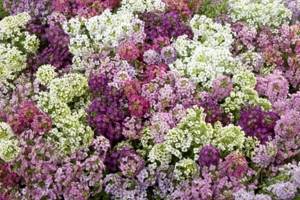
Alyssum (or Lobularia marine) is extremely easy to grow and undemanding to care for. The flower ground cover crop has not only graceful, delicate flowering, but also an attractive honey aroma. Therefore, this crop can be grown to decorate and flavor the garden. Able to reproduce independently in open ground by self-seeding. The conditions required are standard for many plants: a sunny, ventilated place, well-drained, loose soil.
It is optimal to sow alyssum for seedlings at the end of February, in the first and second ten days of March. You can simply sow the seeds superficially over the surface (and then be sure to thin them out), and cover the top with a thin layer of sand (literally 2 mm). Or you can make grooves 3-5 mm deep with a gap of 4 cm from each other, scatter the seeds into the grooves at a distance of 1.5 cm and cover them with sand or soil on top.
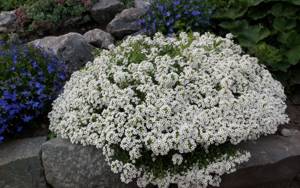
Matthiola bicornuum
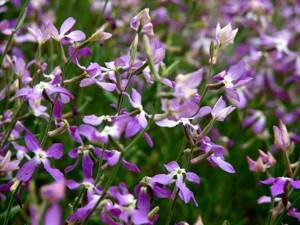
Matthiola bicornuum is planted for its pleasant sweet aroma, which intensively reveals itself in the evening and at night. Annuals are not particularly decorative, so they are used to create a fragrant garden. Blooms from June to early September.
Matthiola bicornuum is planted for seedlings in the second half of March. Seeds should be stratified on a damp cloth in the refrigerator several days in advance. Plant in a wide, low bowl, using not very fertile soil. The seeds are evenly distributed over the soil and covered with a 3 mm layer of sand on top.
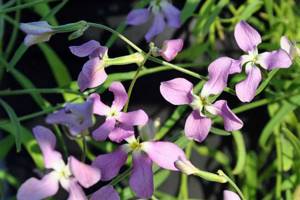
Aster annual (Callistephus)
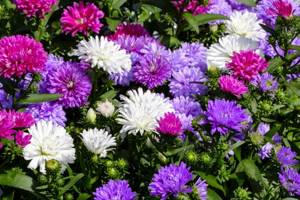
Annual Astra (or Callistephus) is a cold-resistant, drought-resistant plant. Only needs watering in dry weather. The annual aster blooms in August until frost. The culture delights not only with its unpretentiousness, but also with its variety of shades (flowers can be white, blue, red, pink, purple, lilac, etc.). It should be planted in well-lit areas of the garden. Moreover, for the most beautiful flowering, it should grow in a place protected from the wind, which is protected from too bright sun at midday. Callistephus is undemanding when it comes to soil, but it will be more comfortable on loose, moderately fertile, light, permeable soil.
It is optimal to sow annual aster for seedlings at the end of March. Planting is done in a common low bowl, the distance between the seeds is about 2-3 cm, they are covered with soil 5 mm thick.
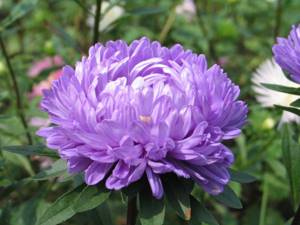
Nasturtium
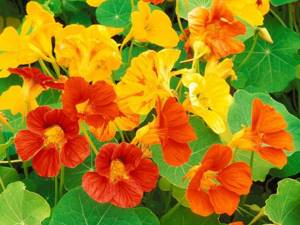
Elegant nasturtium is suitable for vertical gardening, for growing on the balcony. When growing nasturtium through seedlings, flowering occurs from June until the first frost. A flower can easily grow and bloom in the country without careful care, but it is important to satisfy its needs: the plant needs a warm, sunny place, with moderately fertile, loose, moderately moist soil. In terms of caring for nasturtium, it will require regular watering and timely tying to the support.
Nasturtium seedlings are planted at home in April in individual cups; a hole 2 cm deep should be made in the center of the container, the seed should be placed there and covered with soil.
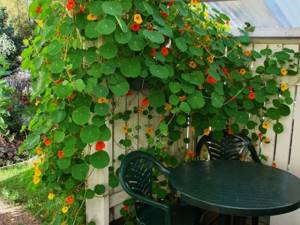
Mallow
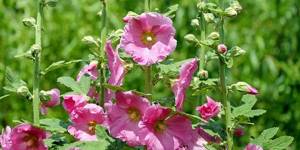
- How to plant: seedlings or seeds.
- When to plant: seedlings - in late May or early June; seeds - in October - November or at the end of April.
- Where to plant: in a sunny, windless place or in partial shade.
- When to bloom: through the summer.
- How long they bloom: from June to September.
Mallow grows tall, so if necessary it needs to be tied up. You can water the plant a couple of times a week, and in hot weather - a little more often. In addition, for better flowering, you should cut off faded flowers.
Undemanding biennials
And among biennial flowers you can find specimens that are distinguished by their undemandingness and hardiness.
Forget-me-not garden
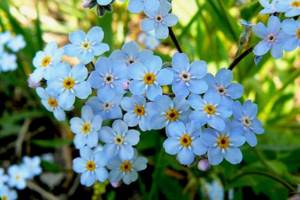
The most unpretentious variety of this crop is the garden (or alpine) forget-me-not. It is a perennial plant, but is grown as a biennial. It blooms for about one month, as a rule, flowering occurs in the second half of May or early June. There are no special features in the agricultural technology of growing forget-me-nots. Feels best in partial shade. It can independently reproduce by self-sowing without the participation of a grower.
To plant forget-me-not seedlings, you need to choose common bowls, the seeds are distributed at a distance of 1.5 cm. They need to be planted very early, in November, December, January.
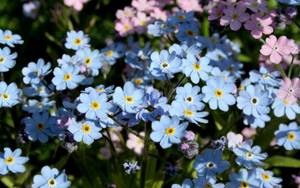
Daisy
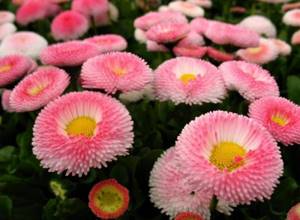
The naive and delicate beauty of daisies will appeal to many. A perennial crop, but grown as a biennial. In general, it is unpretentious in care, with the exception of watering, moisture should be supplied regularly. Growing is optimal in open, sunny places; it is unpretentious in terms of soil, but it is better to plant on drained, light, cultivated soil.
Daisies are planted as seedlings in the second half of March, sown in a common wide and low container. The seeds are evenly distributed over the surface of the substrate, sprinkled with a thin layer of sand (literally 1 millimeter) on top. After the entrances grow, it is necessary to thin them out, removing the weakest ones.
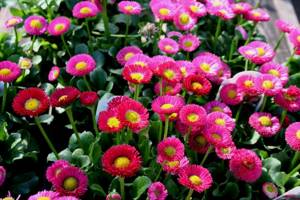
Turkish clove
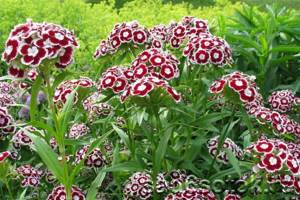
Turkish carnation (or bearded carnation) is another interesting, unpretentious representative of biennial flowers. It blooms in the second year of cultivation (as a rule, flowering lasts 30-45 days, occurring in June). It has interesting colors that can be patterned. Prefers sunny places or areas with diffused light. Blooms from late June until frost.
It is best to sow Turkish cloves for seedlings in late March or early April. It is recommended to initially select individual cups and plastic cassettes (since the crop does not tolerate carelessly picked picking), but you can also plant a common bowl. In the first case, the seed is placed in a hole 3 mm deep and covered with sand or earth. When planting in a common bowl, you need to make grooves with an interval of 3 cm and the same depth, spread the seeds at a distance of 3-4 cm and also cover them.
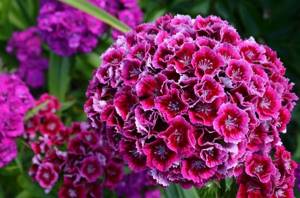
cornflower
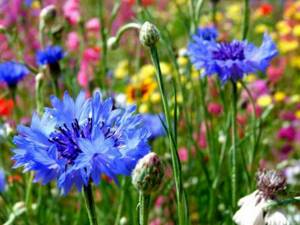
Cornflower is a very hardy flower; it is not afraid of heat, frost, or cold snaps. Only sunny, open places are suitable for him. Drained, fertile soil is also suitable. It is completely undemanding in terms of care. The lovely flowers will look great in any corner of your garden.
It is better to plant cornflower seedlings in early April; seeds are sown in a common box at a distance of 3 centimeters from each other, and the top is covered with soil 3-4 millimeters thick. You can also plant them in cassettes and cups.
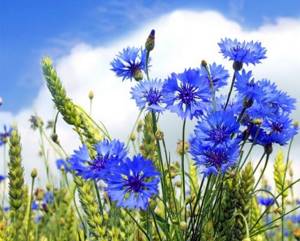
Digitalis
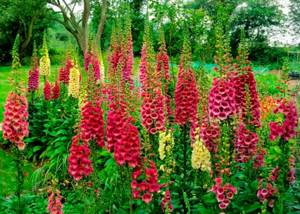
Foxglove (or Digitalis) is undemanding both in terms of care and growing conditions. At the same time, the flowers of this biennial culture are absolutely charming and very decorative! Flowering lasts all summer. Foxglove is resistant to drought and frost. It is recommended to plant digitalis in sunny areas (although they can also grow in partial shade); the soil should be permeable, loose, and fertile.
It is optimal to sow foxglove seedlings in the first half of March. It is necessary to plant in a common low bowl. The seeds are evenly scattered over the surface of the substrate, and sprinkled on top with the thinnest layer of sand or sifted earth (literally 1-2 millimeters).
Important! The plant is poisonous, so you should not grow it if there may be children or pets on the site. It is also necessary to wear gloves when working with the plant.
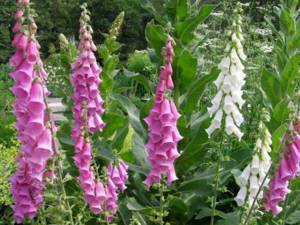
Delphinium
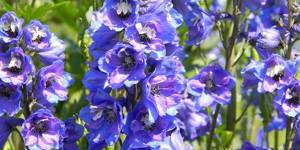
- How to plant: seedlings or seeds.
- When to plant: seedlings - in late May or early June; seeds - in October - November.
- Where to plant: in a sunny, windless place or in partial shade.
- When to bloom: through the summer.
- How long they bloom: from July to late summer.
This tall plant with bright flowers is often planted along fences or walls. Delphinium loves the sun, but it must be planted where there will be shade during the midday hours. Scorching rays can burn delicate flowers. As necessary, the plant should be watered at the root and faded inflorescences removed from it.
What unpretentious perennial flowers to plant as seedlings: names, photos
With perennial flowers, which are unpretentious in care and growing conditions, things are even better. After all, as is the case with annuals and biennials, you do not need to plant seeds for seedlings every year (or every two years). By sowing them once in your garden plot, you can enjoy their beauty for many years without any hassle.
Gaillardia

Gaillardia has very attractive, colorful, cheerful blooms. The perennial is drought-resistant, unpretentious, and thrives in flowerbeds exposed to full sun. The plant self-sows very abundantly. Flowering of gaillardia begins at the end of June and ends at the first frost. The place for growing should be sunny, open, and the soil should be light, loose, drained, and dry. Gaillardia does not need special care, even watering is needed rarely and in small quantities (it does not tolerate waterlogging).
It is optimal to sow gaillardia for seedlings in March, although many summer residents also practice earlier sowing (in January, even December). You can plant seeds either in a common bowl (at a distance of 2 cm) or in individual cups, peat tablets, or cassettes. Sowing is superficial, the seeds are only slightly pressed into the substrate.

Lavender

Beautiful evergreen lavender is suitable for growing in dry, well-drained, infertile soils in a location with very good light. The plant boasts a high decorative value and a pleasant aroma. At the same time, the perennial practically does not need care.
Lavender is sowed for seedlings in the second half of February or early March (but many plant it even in December and January). The seeds are pre-stratified in the refrigerator for 1.5 months. You can sow in a common bowl with a gap of 2 cm, on top they are covered with a layer of sand or soil 3 mm thick.
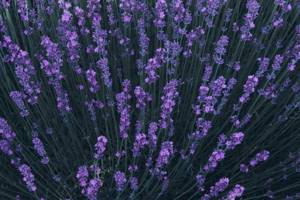
Aquilegia
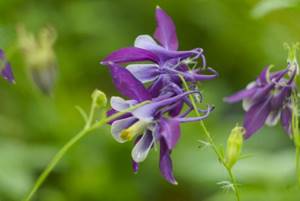
Aquilegia (or Watershed, Orlik) is very unpretentious, capable of growing on the site with virtually no intervention from the gardener. At the same time, it reproduces well by self-sowing, so they can quickly grow throughout the garden. However, when choosing a place to plant a plant, you should choose exclusively shady and semi-shady places in the garden with loose, moist, fertile soil.
Aquilegia is sown for seedlings in March. But at the same time, you need to stratify the seeds in advance for 1-1.5 months, for example, in the refrigerator on a damp cloth. The container for growing seedlings should be deep; a tall bowl will do, or better yet, plastic or peat cups. When sowing, 1-2 seeds should be placed in separate cups; when planting in a common bowl, they are distributed at a distance of 2-3 cm. They are covered with a 5 mm layer of earth on top.
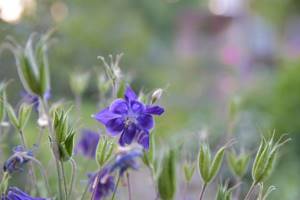
Periwinkle
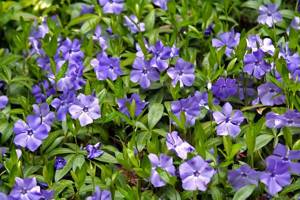
Periwinkle is a very amazing perennial herbaceous evergreen plant that creeps along the ground. The ground cover plant is distinguished by both decorative leaves and beautiful flowers. It is distinguished by incredible vitality and durability, capable of maintaining green leaves even in cold winter. You can plant periwinkle in your summer cottage and not worry about it at all! He feels fine both in strong shade and in bright sun, but he will be more comfortable in a shady or semi-shaded place. Loose, fertile, well-drained soil is most suitable, but can grow in almost any soil.
Growing periwinkle from seedlings is a rather painstaking task, but if you do everything correctly, you can easily achieve success. The seeds are sown in a common bowl with a gap of 4 cm from each other, covered with a 1.5 cm layer of soil on top.
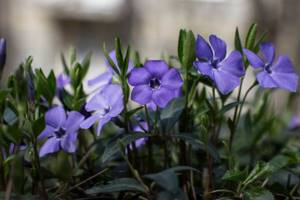
Loosestrife
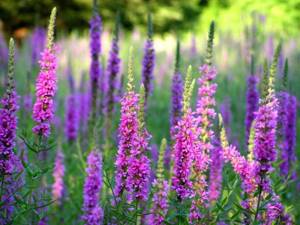
Merlin is a very hardy, unpretentious plant, suitable for those gardeners who are not ready to spend time caring for flowers, but want to see bright accents in the garden. If you immediately plant a perennial in an area with suitable conditions, then you don’t have to worry about the plant at all. It is best to plant loosestrife in sunny areas with moist, nutritious, light soil.
The planting of loosestrife seedlings is usually done in March. Small seeds are evenly distributed over the surface of the substrate. Sowing is superficial, so they only need to be lightly pressed into the ground.
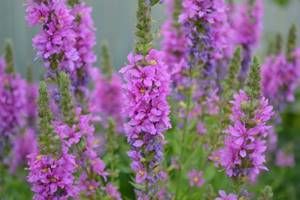
Rudbeckia
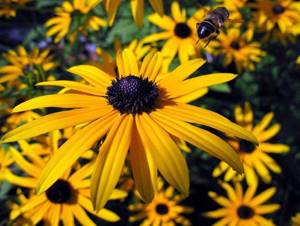
Rudbeckia is a very bright, perky perennial flower (sometimes grown as an annual). It will look great on the site of any dacha or private house. The perennial is quite resilient and undemanding. However, it prefers open places with good lighting. It also does not tolerate drought well, so do not forget about systematic moderate watering. Reproduction of this plant is easily carried out by self-sowing.
You can plant rudbeckia for seedlings at the end of March or at the beginning of April. It is convenient to sow in a common bowl in grooves having a distance of 2 cm from each other and a depth of 0.3 mm. The grooves are filled with earth.
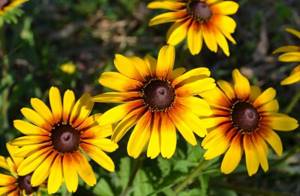
Yarrow
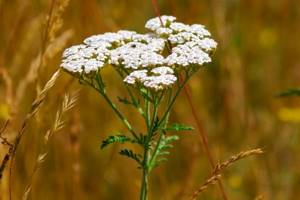
Common yarrow is one of the most unpretentious perennial flowers. It is drought-resistant, frost-resistant, and undemanding to watering. The only thing that needs to be done for this plant is to water it periodically in hot and dry weather. In all other respects, he is completely undemanding! For planting, it is recommended to choose sunny areas with well-drained, permeable, loose soil. By the way, the perennial grows on any soil, even very poor soil. Flowering begins in late spring and ends in late summer.
It is also worth considering that the plant grows strongly by self-sowing, so you will have to control the plant so that it does not take over everything around it (for example, immediately pick off faded inflorescences to prevent the seeds from falling off).
It is better to plant yarrow seedlings at the end of February or at the beginning of March. It is most convenient to use a wide and not very high drawer. A distance of about 2-3 cm should be maintained between the seeds. They are covered with a 2 cm layer of soil on top.
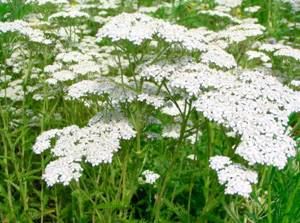
Heliopsis
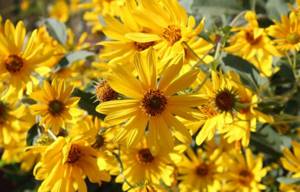
Heliopsis is a cheerful, sunny flower that prefers dry, well-lit places. It is undemanding, drought-resistant, and winter-hardy. Growing this perennial is easy, so it is suitable even for a novice gardener.
You can plant heliopsis seedlings in March, but first you need to place the seeds in a damp cloth in the refrigerator for stratification for 1 month. When planting, it is recommended to maintain a distance of about 5 cm between them, then they are covered with a 1 cm layer of soil.
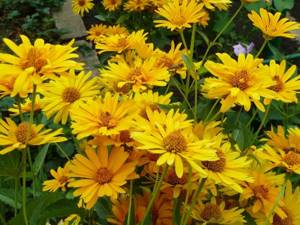
Mallow
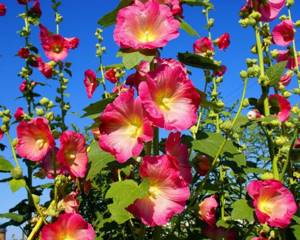
Mallow (or hollyhock, alcea) is often grown as a biennial flower because after the 2nd year it becomes less decorative. A tall plant is planted along fences, walls of buildings, and garden paths. For all its decorativeness, mallow is completely unpretentious.
Sowing hollyhock roses at home is done in early March. It is better to immediately choose deep individual containers (cups, cassettes). 2-3 seeds are placed in one container (and then the strongest seedling is left), covered with a 1 cm layer of soil.
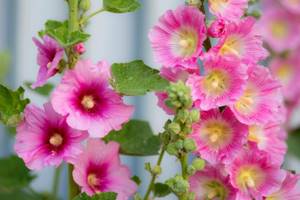
Nivianik (leucanthemum, garden chamomile)
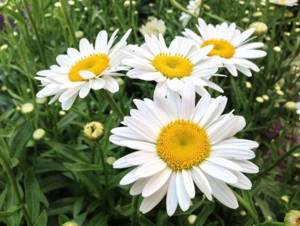
Nivyanik (or Leucanthemum, Garden Chamomile) has magnificent white flowers with a yellow center. Garden chamomile is loved by many gardeners in our country due to its delicate appearance. Leucanthemum prefers sunny places with fertile, moist soil.
Nielweed is sown at home in early March. In terms of choosing containers, there are no special preferences; it can be either a common box or individual cups. The seeds are buried 1 cm, the distance between them is 3-4 cm.
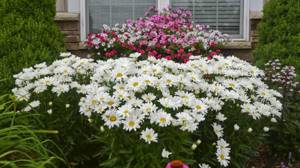
Echinacea purpurea
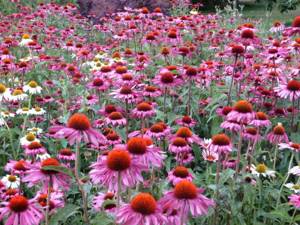
Echinacea purpurea is heat-resistant, drought-resistant, and frost-resistant. It is better to plant the plant on fertile, loose soils, in an open, well-lit place.
You can plant Echinacea purpurea at home in the second half of February. It is necessary to prepare the seeds by soaking them in a damp cloth with a solution of a growth stimulator, or at least in regular warm water until they bite. In a common box, you need to make grooves 0.5 cm deep at a distance of 3 cm from each other and arrange the seeds at the same distance as the grooves. Sprinkle a 1-2 millimeter layer of sand on top.
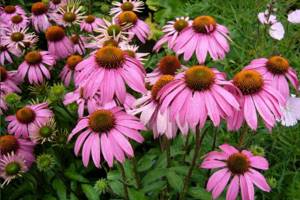
Lupine
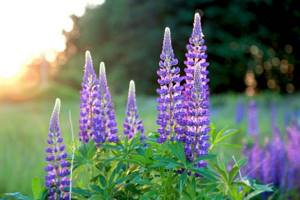
Beautiful lupine is completely undemanding and unpretentious. It is unpretentious to soils, but prefers well-lit places. If perennials grow in a windy place, it is recommended to tie a long stem to a support.
Lupine seedlings are planted at the end of March and April. Planting material must be pre-soaked before biting. An important feature of growing lupine seedlings: plants need nitrogen-fixing bacteria, so it is recommended to mix the seeds with crushed tubers from the roots of old lupins. The seeds are laid out on the substrate at a distance of 5 cm, sprinkled with sifted soil on top with a layer of 5 mm.
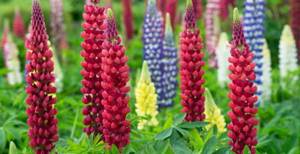
Ammobium
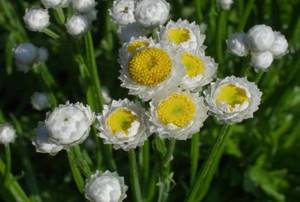
Ammobium is extremely unpretentious and drought-resistant. Many people grow it as an annual. Its flowering is abundant and long: from mid-June to late autumn. Able to grow and bloom normally even on very poor soil (including on a substrate with a high sand content). Feels best in sunny, warm areas with sandy, loose soil.
It is better to plant ammobium seedlings in early April. A soil mixture with added sand should be used. In a common box, the seed is laid out at a distance of 2-3 cm, and the top should be covered with sand or soil (layer thickness about 3 mm).
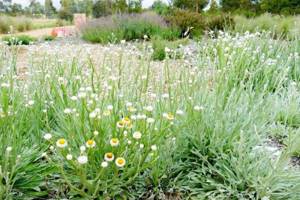
Arabis
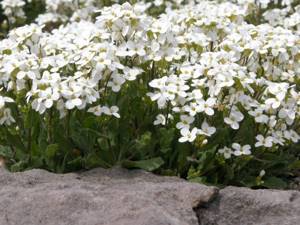
Arabis is ideal for decorating rock gardens, alpine slides, and rocky ground. The flowering of the perennial is modest, but interesting and sophisticated. The ground cover plant grows well in full sun, dry, sandy, loose soil.
It is optimal to plant Arabis at home in early April. The substrate must contain sand and small stones. Arabis seeds are evenly distributed in a bowl, covered with sand or soil on top (literally 3 mm).
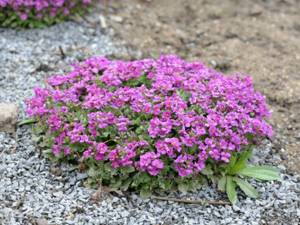
Gypsophila
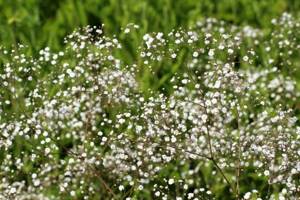
Aerial gypsophila (or Kachim) can add elegance, lightness and tenderness to any flower garden! Hardy and frost-resistant crop. A good location for baby's breath: sunny, open, dry, well-drained soil with lime.
It is necessary to sow gypsophila for seedlings at the end of March. For this purpose, low general containers are used, the seed is evenly distributed over the surface, and sprinkled with soil (2 mm) on top.

Bluebell Carpathian
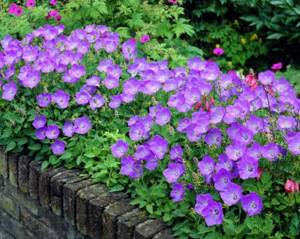
Carpathian bellflower is loved by gardeners because of its elegant, delicate flowers. It is undemanding in care, characterized by winter hardiness, resistance to pests and diseases. Flowering lasts about two months, occurring in the first two months of summer. Ideal for growing on an alpine hill. Prefers open, sunny areas; it is optimal to choose well-drained, slightly alkaline or neutral soils.
Bellflower seedlings are planted throughout March. It is convenient to sow small seeds in a common bowl, after mixing them with river sand. The planting is shallow, so it cannot be covered with soil.
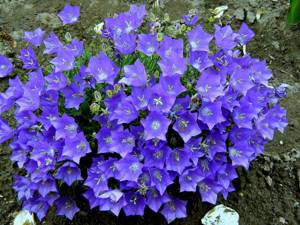
small petals
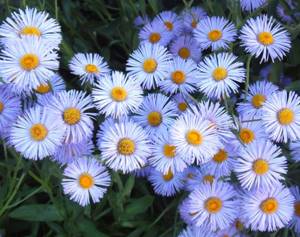
Small petal (or Erigeron) is distinguished by interesting flowers that have very thin petals. They are easy to care for, unpretentious and decorative, so they are often planted in garden plots in sunny places.
Small petal seeds are sown superficially for seedlings in March in a common container. They are only lightly pressed into the soil.
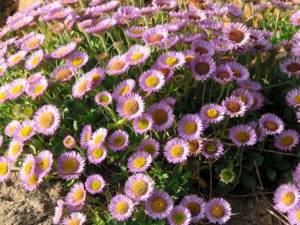
Doronicum
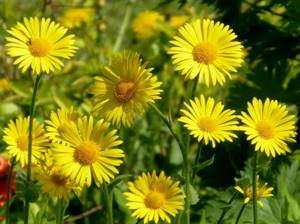
The sunny flower Doronicum is completely unpretentious. Looks interesting in single plantings and in compositions with other flowers. Flowering from mid-May to mid-June.
Sowing Doronicum at home is carried out in April in plastic cassettes. 2-3 seeds are placed in one cell to a depth of 3 mm. Later, you should leave one strongest sprout in one cell.
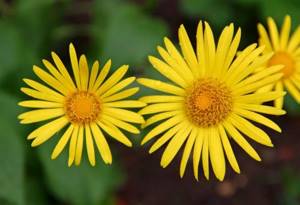
Important! Despite the general unpretentiousness of the listed flower crops and low maintenance requirements, it must be remembered that plants cannot be completely deprived of care. Indeed, in this case they will bloom inconspicuously or may even die. It is necessary to water regularly, and, if possible, not to ignore fertilizing, loosening the soil surface, and removing weeds.
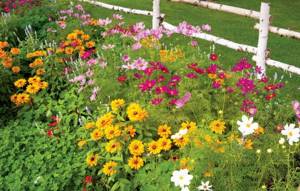
If you sow seedlings and then plant unpretentious flowers in open ground, you can get a beautiful garden without unnecessary hassle and effort. Fortunately, there is a large selection of annual, biennial and perennial plants that have bright and beautiful flowering, but do not require painstaking and careful care.
Lupine
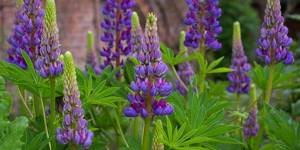
- How to plant: seedlings or seeds.
- When to plant: seedlings - at the end of May; seeds - in October - November or mid-April.
- Where to plant: in a sunny, windless place or in partial shade.
- When to bloom: through the summer.
- How long they bloom: from June to July.
This plant has very beautiful elongated inflorescences of different shades. Perennial lupine needs to be watered regularly. And if you cut off the flowering stems from it in time, you can achieve repeated flowering at the end of summer. Sometimes lupine can bloom in the year of planting, at the end of summer.
May lily of the valley
The very name of this low-growing herbaceous perennial indicates the time of its flowering. The delicate snow-white, pot-bellied bells of its inflorescences with a magnificent aroma against the background of wide green leaves usually bloom in mid-May and delight the eye for about a month. Recently, unusual varieties of lily of the valley have been developed - for example, with large double flowers or striped leaves.
The flower is unpretentious, frost-resistant, and tolerates partial shade. It loves soil rich in organic matter, a moderately moist place, where it can grow for many years, spreading in all directions.
The entire lily of the valley plant is very poisonous - be careful if you regularly have small children or pets in your area. You also need to be careful when cutting flowers and propagating by dividing the rhizome.
Perennial
For those who don't want to sow seeds every year, consider perennial crops such as:
- Aquilegia;
- Periwinkle;
- Cornflowers;
- Nivyanik;
- Bell.
Aquilegia blooms in the second year. Drooping inflorescences with a wide color palette: white, yellow, crimson, blue. They reach 6-9 cm in diameter. The flower loves partial shade. Tolerates snowy, frosty winters well.
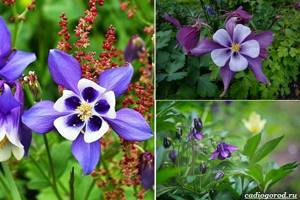
Aquilegia has many varieties, and they are all very unusual and beautiful
Periwinkle is an evergreen perennial crop. Blooms from early spring. Does not require constant watering and care. Flowers of delicate shades. Plantings are successfully used in landscape compositions.
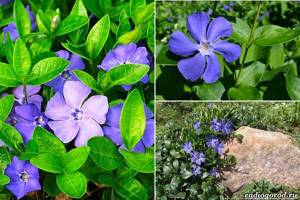
Periwinkle grows quickly and occupies free territory, this is important to consider when planning a flower bed
Cornflower does not require special care and is characterized by many shades. Capable of adding variety to any flower garden. The branched stem grows up to 1 meter. The inflorescences are small. Common colors: white, blue. The plant loves sunny places. Looks great paired with chamomile and calendula.
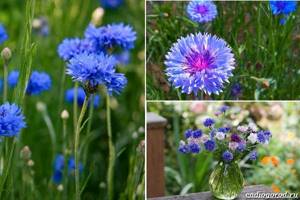
Cornflowers are delicate and pleasant unpretentious flowers
A novice florist may confuse cornflower with chrysanthemum or chamomile. The plant is distinguished by the absence of a characteristic odor. The diameter of large flowers is 60-120 mm. It blooms twice per season: May-July, August-September. Grows in one place for 5-7 years.
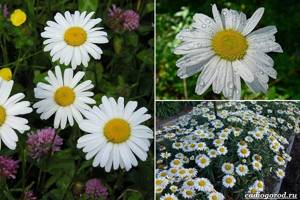
The second name for nivyanika is garden chamomile. It differs from the usual one in its larger flower size
Bluebell loves sunny places and light partial shade. There are up to 400 species of this flower. In gardens there are specimens not only with a blue tint, but also with pink and lilac. Alpine slides, borders, and vertical compositions are decorated with bells.
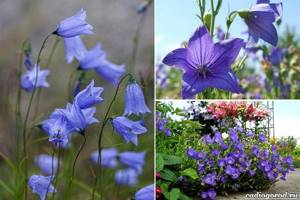
Fast Growing Houseplants
Landscaping a room is a stage of creating comfort. And for this, not everyone can afford to buy adult plants, which cost significant amounts. When purchasing sprouts, there is no complete guarantee of the effectiveness of long-term cultivation. The solution is unpretentious, fast-growing plants, which in a couple of months will become full-fledged green islands.
Scindapsus
Scindapsus camouflage walls, shelves, and have variegated egg- or oval-shaped foliage with sharp tips.
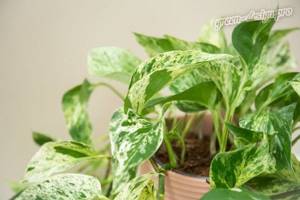
Scindapsus
An adult plant is from half a meter to 3 m in length, depending on the variety. The steeplejack reaches a meter in a year. Suitable even for the bathroom, as it can grow in the shade and likes high humidity.
Ceropegia
Thread-like branching shoots with paired opposite leaves of this ampelous succulent look like green lace.
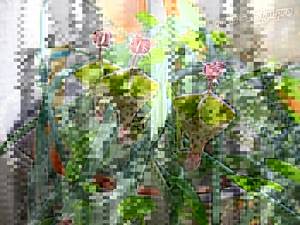
Ceropegia blooms almost all year round. The shoots reach a meter. Requires minor feeding, watering without waterlogging, pruning and sunlight.
Tradescantia
A dense tradescantia bush with velvety leaves will appeal to any gardener.
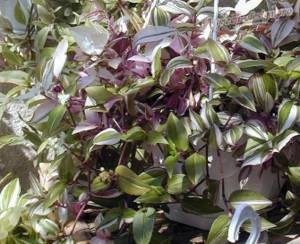
The length of the plant reaches 60 cm, while the leaf plate is reddish in color - up to 30 cm. Care consists of diffused lighting, regular watering and assumes the possibility of forming a crown.
Clerodendrum
A dense 2 m clerodendrum bush with a dense crown, beautiful flowering, and most importantly fast growth, will appeal to anyone. The 12 cm oval green leaves have beautiful embossed veins and pointed tips.
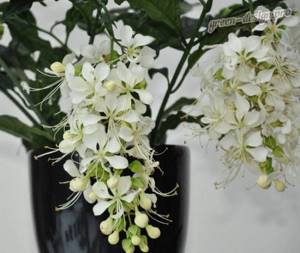
In solo parts, the bush looks great as a zoning plant. And at the same time, it blooms both for several months and throughout the year - with proper care. In summer, such fast-growing indoor plants add up to 8 cm per day and only require:
- cool damp air;
- regular soil moisture;
- good lighting.
Rose
The most popular flower, repeatedly sung by poets, is actually not as delicate as it seems. Roses grow safely in both Siberia and the Far North. Rose hips, or species roses, are the most frost-resistant, and the decorative varieties bred on their basis have inherited this feature. If species roses are used as a rootstock for cultivated varieties, then such plants do not need to be covered for the winter - they withstand both frost and temperature changes. All other types and varieties of roses must be covered with spruce branches, spunbond or fallen leaves.
- How to help roses overwinter - tips for covering and storing bushes
In order for roses to safely survive winter frosts, they need to be taken care of in advance. How to cover roses correctly?
short
These plants are extremely popular among gardeners. They are small, but at the same time graceful, forming a thick carpet on the site. Most low-growing flower crops are undemanding and survive winter cold without problems.
Armeria seaside
A herbaceous crop reaching a height of 20 cm. Not only its flowers, but also its leaves are considered decorative. They grow into a dense bush that can be divided to propagate the flower.
For normal growth, perennials require slightly acidified soils. It looks especially impressive along borders and in containers. Buds of all shades from white to red appear in May and bloom until September. For the winter, the armeria is covered with straw or fallen leaves.
Related article:
Indoor flower Dracaena - female dragon. How to tame
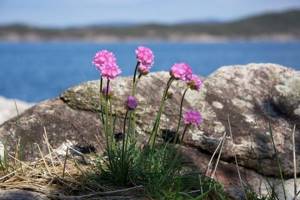
Gypsophila
Herbaceous plant of the Clove family. The birthplace of the culture is Southern Europe and Asia. She loves limestone soils and well-lit areas. The soil must be well permeable: gypsophila does not tolerate stagnant water.
Low-growing varieties are ground-covering forms with creeping stems. The branches are almost devoid of leaves: most of them are located in the basal part. Buds up to 7 mm in diameter appear in June. They are collected in panicle inflorescences growing in the shape of a ball. Color in pastel colors: white, lilac, pink. Gypsophila looks impressive in large flower beds and under trees.
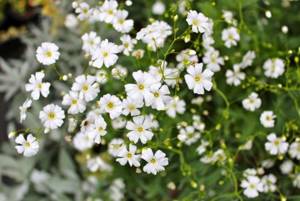
English rose
Low-growing varieties reach a height of 30 cm. This is a universal, unpretentious flower, which differs from ordinary garden roses. There are many types of crops with varied colors and diameters of inflorescences.
Related article:
5 best perennial honey plants that you can plant on your site
Street roses do not like overly lit areas: 5 hours of daylight is enough for them, so they can be planted in partial shade. These beautiful perennials, blooming all summer, love to grow in higher elevations and are great for flower beds, flower beds, and borders.
You can learn more about English roses bred by David Austin in the article
Rudbeckia
The height of the plant rarely exceeds 30 cm. It can grow in one place for up to 8 years. The culture loves sun, partial shade and regular watering. Hot weather and drought are detrimental to the flower.
The perennial leaves are elongated. The petals are arranged in 1-2 rows, slightly curved outward, mostly yellow and orange. Externally, the inflorescences resemble chamomile. The middle of the flower is black, convex, fleecy.
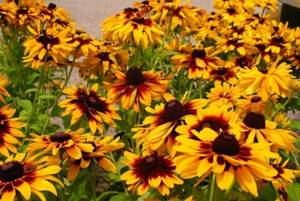
Chrysanthemums
Low-growing varieties are perfect for growing in flower beds. There are about 50 subspecies in total. The inflorescences resemble small baskets of different shades. More often, Korean and Indian varieties are used for planting in the front garden or local area. Among the variety of species, you can choose those suitable for mild climates and frost-resistant.
Related article:
5 beautiful flowers that will delight you with their blooms in August
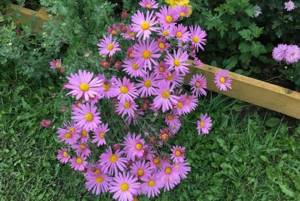
Alpine
Dicentra
This perennial belongs to the poppy family, although it is not at all similar to the mentioned flower. Plants of this genus are famous for their carved leaves and original heart-shaped flowers, which can be white, crimson, pink and red, and bloom from early May to mid-June (and some until autumn).
All types of dicentra are quite frost-resistant. They prefer light, well-drained, moist soil rich in humus; Grow best in sparse shade. After flowering, the aboveground part of both “falls asleep” until spring. Sometimes dicentras bloom again in August-September.
In landscape design, the plant is used to create high borders and rockeries, as well as for single plantings. Dicentra care involves mulching the soil and irregular watering on especially dry summer days.
- Growing dicentra in the garden
Everyone knows this amazing plant with clusters of hearts hanging from the branches. But how to grow it?
Unpretentious
If you rarely visit your dacha and have absolutely no time to care for flower beds, pay attention to these easy-to-care plants:
- Botanical tulip;
- Zinnia;
- Dahlia;
- Alyssum;
- Rudbeckia.
The botanical tulip rightfully takes first place among unpretentious flower crops. Resistant to diseases and insect pests. It does not need to be dug up for the winter. Blooms from early spring. The color palette is varied. Some subspecies grow up to 50 cm.
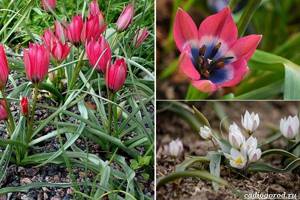
Zinnia begins to bloom in summer and ends in autumn. The flowers are bright, rich colors. On one base there is one flower, 5-12 cm in size. It grows up to 20-100 cm, depending on the subspecies. The cut plant looks great in vases.
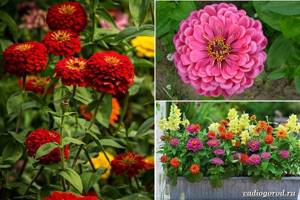
The flowering period of dahlias occurs at the end of June and continues until the first frost. The color palette is extensive, as is the shape of the inflorescence itself. Looks aesthetically pleasing in the design of flower beds or border lines. If you don’t want to dig up plant tubers every fall, purchase seeds of annuals. The optimal place for growing dahlias is sunny, ventilated areas.
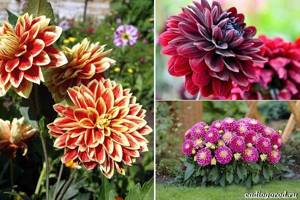
There are 100 species of alyssum . This is an unpretentious, frost-resistant, drought-resistant ground cover planting. Forms a small shrub. The flowers are shaped like brushes. The color palette is varied. It blooms from the second half of spring until the first frost. There is a characteristic honey aroma.
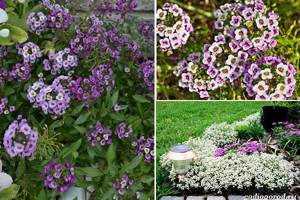
Bright specimens of rudbeckia will successfully complement the site. The plant requires little care. Even a novice summer resident can cope. Rudbeckia mainly has a yellow color scheme. Tall plantings quickly take up free space. Therefore, it is recommended to plant behind other flower crops. The plant is disease resistant. Flowering lasts until late autumn.
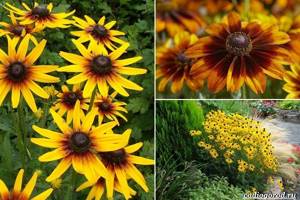
Tulip
Well-known and beloved tulips have so many shapes, varieties and varieties that even the most capricious gardener will choose a flower to suit his taste - including the flowering period.
In May, you will be able to delight with the bright colors of simple and double early tulips, Triumph tulips, Darwin hybrids, lily-flowered tulips, Rembrandt tulips, some fringed and green-colored ones... And if you don’t know how they differ from each other, our detailed material is for you to help.
- 15 main types of tulips - do you have everything (photos, descriptions, varieties)?
All classes of tulips in one article
